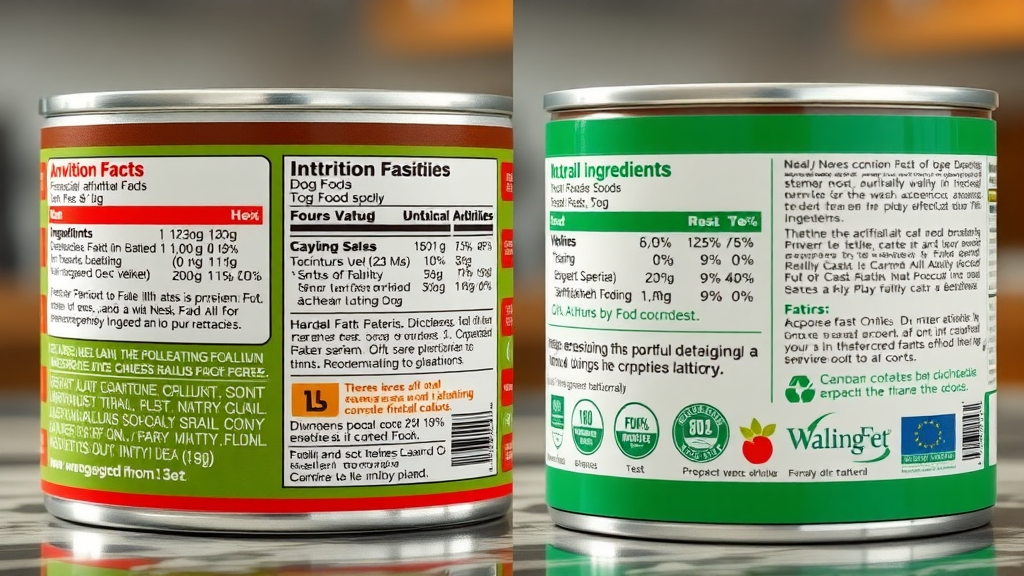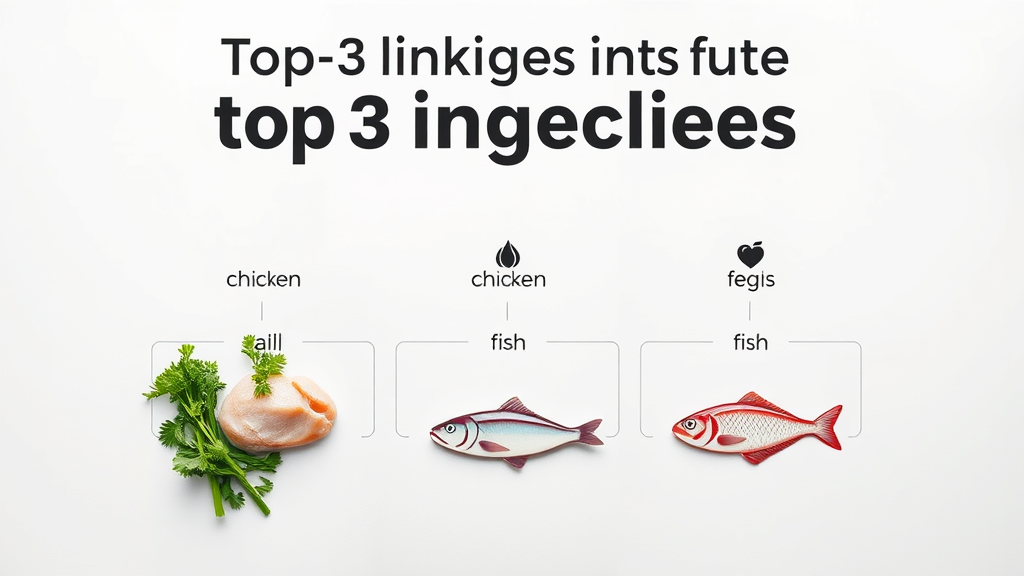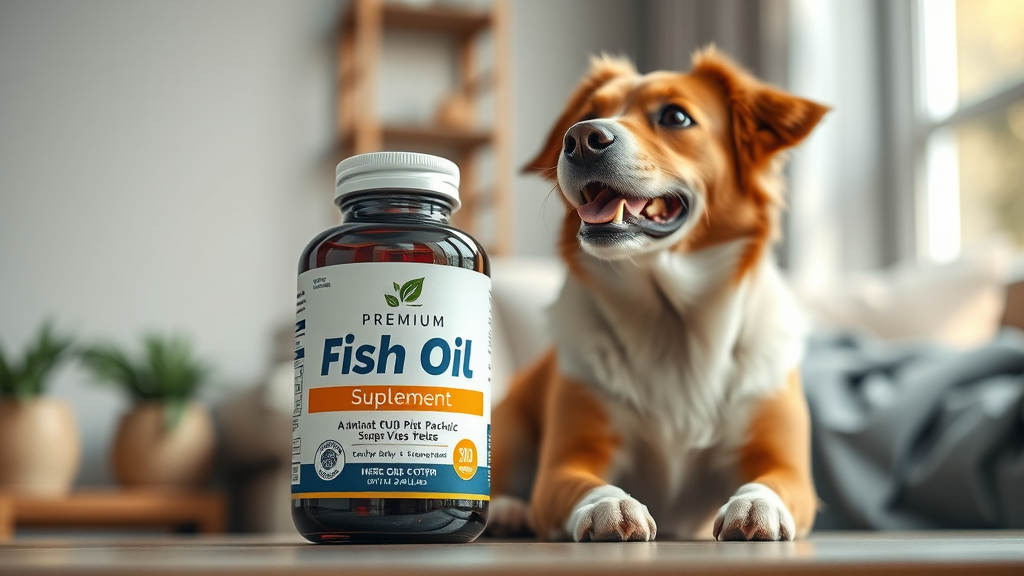Did you know that over 40% of commercial dog food contains at least one ingredient linked to potential health risks ? If you're like most pet owners, you want your furry companion to live a long, healthy life—yet the food you’re pouring into their bowl every day could be hiding threats you didn’t expect. In today’s food industry, marketing buzzwords often obscure the true nature of dog food ingredients, leaving caring owners in the dark. This article will equip you with the knowledge to decode food labels and make smarter, safer choices for your dog’s nutrition—starting today.
Did You Know? Shocking Facts About Dog Food Ingredients in Commercial Pet Food

- Recent studies reveal that over 40% of commercial dog food contains at least one ingredient linked to potential health risks. Learn why scrutinizing food labels is essential for your dog's long-term well-being.
When you browse the aisles searching for the best dog food, you're often greeted by vibrant packaging boasting “premium” or “healthy” claims. Yet, beneath these eye-catching labels, many dog foods include additives, fillers, and preservatives with questionable health effects. Some common food ingredients like BHA, BHT, and ethoxyquin, used as artificial preservatives , have been flagged by experts as risky, especially with long-term exposure.
More alarming, regulatory loopholes allow food manufacturers to use generic terms such as “meat meal” or “animal byproducts” without specifying what’s actually inside. This lack of transparency means your dog might be eating low-quality sources of protein—or worse, useless fillers that do little for their health. Recognizing these red flags empowers you to bypass harmful products and select foods that actively support your pet’s vitality.
Decoding Dog Food Ingredients: Understanding Food Labels for Pet Food Safety
How to Read a Dog Food Label and Identify Problematic Food Ingredients
- Ingredient order and definitions
- Hidden additives in dog food labels
- Misleading terms on pet food labels
The food label on your dog’s food bag is a powerful tool—if you know how to read it. Dog food ingredients are listed in order of weight, with the most prominent ingredients first. If a real animal protein (like “deboned chicken” or “salmon”) tops the list, that's a positive sign. However, if you see corn, wheat, or soy high up, you’re likely looking at a filler-heavy product. Terms like “meat meal” or “animal digest” are intentionally vague, often disguising poor-quality protein sources.
Many labels hide additives and artificial preservatives under unfamiliar chemical names or umbrella terms like “flavor” or “color.” Even “natural” pet food claims can be misleading if artificial colors, flavors, or preservatives are still present. Scrutinizing labels for specifics—such as the protein source, type of fat, and clear identification of preservatives—helps you avoid problematic ingredients and prioritize your dog's health.
What You'll Discover in This Guide to Dog Food Ingredients
- Essential nutrients every dog needs
- How additives, preservatives, and fillers impact dog health
- Practical tips to select safer dog food products
- Common artificial and natural preservatives to watch for

Armed with science-backed facts and expert recommendations, you’ll learn which dog food ingredients genuinely nourish your pet and which do more harm than good. This guide covers every aspect of pet food safety: understanding ingredient functions, evaluating common additives and preservatives, spotting red flags, and leveraging vet-approved selection strategies. By the end, you’ll have both a reliable shopping checklist and the confidence to make ingredient-first decisions for your dog’s well-being.
The Building Blocks: Basic Dog Food Ingredients Explained
What Are the Basic Ingredients of Dog Food?
- Proteins: amino acids, bone meal
- Carbohydrates: beet pulp, grains
- Fats: fish oil and meat fats
- Vitamins and minerals: essential nutrients
At its core, dog food is designed to deliver a complete and balanced diet—meeting your pet’s essential nutrient needs through a blend of key food ingredients . Animal protein sources such as chicken, beef, or fish provide amino acids crucial for muscle development, lean muscle mass, and general vitality. Fillers like beet pulp, corn, or rice deliver carbohydrates for energy, but their quality varies. Healthy fats, from fish oil or chicken fat, enhance nutrient absorption, cognitive function, skin, and coat health. Finally, a range of vitamins and minerals —often in the form of supplements or chelated minerals—provides the micronutrients needed for everything from immune system strength to bone health.
Understanding why each ingredient is present—and prioritizing quality, recognizable sources—makes a dramatic difference in your dog’s digestive health, energy, and long-term well-being. Avoiding vague protein sources and artificial additives ensures your dog isn’t exposed to questionable substances that may harm their health in the long run.
Answer: The core dog food ingredients typically include animal proteins, grains or vegetables, fats, and an assortment of vitamins and minerals to ensure nutritional needs are met. Understanding the source and quality of these food ingredients is crucial when choosing safe dog food.

Essential Nutrients in Dog Food Ingredients: Why Quality Matters in Pet Food
Amino Acids and Essential Nutrients: The Foundation of Healthy Dog Food
- Complete proteins vs. incomplete proteins
- Role of amino acids and essential nutrients in health
- Natural sources of essential nutrients in dog food
Amino acids are the building blocks of protein—and not all proteins are created equal. Complete proteins, like those from fish and chicken, provide all the essential amino acids your dog’s body can’t produce itself. These proteins help maintain lean muscle mass , bolster the immune system, and support healthy organs. Incomplete proteins (e.g., corn or soy) lack several essential amino acids and should not be relied on as a sole protein source in pet food.
Beyond protein, dogs require a spectrum of essential nutrients —including fatty acids, vitamins, and minerals—to thrive. These nutrients fuel energy, repair tissues, promote digestive health, and facilitate hundreds of critical bodily processes. The best pet food contains naturally derived sources of these nutrients, such as salmon for omega-3 fatty acids, organ meats for vitamin A, and whole grains or eggs for B vitamins.

"Just like humans, dogs thrive when their diet contains a variety of high-quality amino acids, essential nutrients, and fewer fillers." – Dr. Linda Brooks, Veterinary Nutritionist
Vitamins, Minerals, and Supplements: Key Dog Food Ingredients to Look For
- Commonly added vitamins and minerals
- How to check for quality supplements in food ingredients
- The role of chelated minerals in dog health
Vitamins and minerals are often added to ensure the food meets established canine nutrition standards. Key micronutrients to look for include vitamin E (an antioxidant), B vitamins (for energy), and minerals like calcium and phosphorus (for bone health). Supplements can be especially beneficial if they’re sourced from whole foods or appear as “chelated minerals,” which are more absorbable and effective compared to their non-chelated counterparts. Read food ingredients closely: reputable brands specify the vitamin or mineral form, while low-quality foods may just list generic “vitamins and minerals.”
Avoid “supplement overload.” Instead, look for food labels indicating natural sources of these nutrients, and double-check that the list isn’t compensating for low-quality base ingredients with excessive fortification. Balanced, whole-food nutrition always outperforms synthetic-heavy formulas over time.

Top Recommended Dog Food Ingredients for Optimal Canine Nutrition
What Are the Best Ingredients to Feed Your Dog?
- Animal proteins: chicken, beef, fish
- Healthy fats: omega-3 fish oil
- Wholesome vegetables and fruits
- Natural preservatives and antioxidants
The best dog food ingredients are straightforward, unambiguous, and rooted in nature. Prioritize foods where the leading ingredient is a named animal protein—like “chicken,” “turkey,” or “salmon”—as this ensures your dog receives adequate essential amino acids for lean muscle and energy. Wholesome carbohydrates (from sweet potatoes, peas, or brown rice) and a mix of vegetables and fruits deliver dietary fiber, vitamins, and minerals for robust digestive health.
Healthy fats, particularly those sourced from fish oil , enrich the food with omega-3 and omega-6 fatty acids , promoting healthy skin, a shiny coat, and good heart function. Natural antioxidants, such as vitamins C and E, along with plant-based ingredients, help mitigate oxidative stress and support the immune system. Foods using rosemary extract or mixed tocopherols as natural preservatives are preferable to formulas loaded with artificial chemicals.

Answer: The best dog food ingredients emphasize real animal proteins, healthy fats like fish oil, digestible carbohydrates from vegetables, and minimal artificial preservatives. Aim for foods with clear, recognizable food ingredients on the label.
Spotting Harmful Dog Food Ingredients on Labels
Common Artificial Preservatives and Additives to Avoid in Dog Food
- Artificial preservatives: BHA, BHT, ethoxyquin
- Artificial colors and flavors
- Potential long-term health impacts
Artificial preservatives such as BHA, BHT, and ethoxyquin are used for shelf stability, but they have been linked in scientific studies to possible long-term health consequences like cancer and organ damage. Artificial colors and flavors do nothing to improve your pet’s health and are included solely for marketing appeal or to mask inferior food ingredients.
Check your food label —if artificial preservatives dominate the ingredient list , this is a red flag. Prioritize foods where natural preservatives (like vitamin E or C, also known as mixed tocopherols or ascorbic acid) keep the food fresh and safe instead.

Natural Preservatives: Are They Safer Dog Food Ingredients?
- Mixed tocopherols
- Rosemary extract
- Vitamin C and E
Natural preservatives are generally safer and better tolerated by most dogs compared to artificial chemicals. Mixed tocopherols (vitamin E compounds), rosemary extract , and ascorbic acid ( vitamin C ) extend shelf life without increasing potential toxicity. These natural preservatives not only keep fats from becoming rancid but can also contribute antioxidative benefits to your dog’s diet.
Look for plainly labeled foods specifying their preservative sources, and avoid products with excessively long ingredient lists filled with hard-to-pronounce chemical names. Remember—less is often more when it comes to safe, nutritious dog food ingredients.
Filler Ingredients and Byproducts in Dog Food: What Pet Owners Should Know
What Is the Main Filler in Dog Food?
- Corn, wheat, soy as common fillers
- Why excessive fillers are problematic
- How fillers affect dog digestion and health
Corn, wheat, and soy are the three most common fillers found in commercial dog food. While inexpensive for pet food manufacturers, these ingredients provide little nutritional value compared to real animal proteins or whole vegetables. Excessive fillers can trigger allergies, upset digestive health, and crowd out the essential nutrients your dog actually needs.
Dogs with sensitive stomachs may experience bloating, gas, or inconsistent stool quality on diets high in fillers. Over time, a filler-heavy diet can compromise the immune system and lead to deficiencies that undermine your pet’s well-being. Always opt for foods that list animal protein—and not corn, wheat, or soy—as the first ingredient, and read labels closely for the presence of cheap bulking agents.

Answer: The main filler in dog food is often corn, wheat, or soy. These dog food ingredients are used to bulk up dog food cheaply, but they provide little nutritional value compared to real animal proteins and healthy whole grains or vegetables.
The 3-Rule on Dog Food: Simplifying Dog Food Ingredients for Better Choices
What Is the 3 Rule on Dog Food?
- Choose dog foods where the first three ingredients are real, recognizable proteins or whole foods
- Avoid dog food ingredients with unpronounceable or artificial additives at the top of the food label
- Ensure essential nutrients are not replaced by fillers
The “ 3-rule ” is a smart shortcut for finding higher-quality dog food ingredients . Focus on the first three ingredients listed on the food label—if these are real animal proteins or whole foods like “chicken,” “salmon,” or “sweet potato,” you’re on the right track. If instead you spot generic byproducts, fillers, or artificial additives leading the list, reconsider the purchase.
Remember, the ingredients are listed in order of weight—so the first three have the greatest impact on the product’s nutritional content. Adhering to this simple rule helps ensure your dog’s diet isn’t diluted by low-value or even harmful substances masquerading as “nutrition.”

Answer: The 3-rule recommends pet owners focus on the top three ingredients listed on the dog food label: they should be high-quality proteins or whole foods, not cheap fillers or unidentified byproducts. This helps ensure your pet food offers the essential nutrients necessary for long-term health.
Ingredient Spotlight: Popular and Controversial Dog Food Ingredients
Dry Dog Food and Dry Dog Ingredients: Pros and Cons
- Shelf-stability versus risk of dehydration
- Artificial vs. natural preservatives in dry dog food
- Nutrient density in dry dog food
Dry dog food offers convenience and a longer shelf life, often due to chemical or natural preservatives. While dry food is cost-effective and can help with dental health, its low moisture content can lead to dehydration, particularly if your pet doesn’t drink enough water.
Check whether preservatives are natural (such as mixed tocopherols) or artificial—the latter can degrade health with prolonged use. High-protein, low-filler dry dog foods can be a good source of balanced nutrition, but always ensure that the food’s first ingredient is a quality animal protein.
Bone Meal and Beet Pulp: Necessary or Dangerous?
- Role of bone meal in pet nutrition
- Controversy over beet pulp in dog food ingredients
- Regulation and safety standards for these additives
Both bone meal and beet pulp are common dog food ingredients with debated health impacts. Bone meal provides calcium and phosphorous, but poor-quality or excessive inclusion brings contamination risks. Only choose brands transparent about sourcing and processing methods. Beet pulp is a fiber source that can aid digestive health , but too much may dilute other valuable nutrients and cause digestive upset in sensitive dogs.
Look for products where bone meal and beet pulp are not among the first three ingredients, and confirm through brand transparency or independent certifications that these additives meet strict safety standards.
Fish Oil, Omega Fatty Acids, and Other Beneficial Additives
- Benefits of DHA and EPA for skin, coat, and heart health
- How to verify fish oil quality in dog food ingredients
Fish oil is prized in dog nutrition for its supply of omega-3 fatty acids (DHA and EPA), which support heart health, a glossy coat, joint mobility, and cognitive function. Not all fish oil is created equal—seek brands using sustainable, contaminant-free sources, clearly marked as “salmon oil” or “menhaden fish oil.”
Beneficial additives like glucosamine, chondroitin, and probiotics can further support joint and digestive health. Vet-recommended foods specify both the source and quantity of these nutrients, supporting overall wellness rather than just bulking up the ingredient list.

Red Flags: Signs of Low-Quality Dog Food Ingredients
- Generic meat byproducts and vague ingredient terms
- Artificial preservatives dominating the ingredient list
- Extensive use of fillers instead of proteins or whole foods
| Signs of Quality | Red Flags |
|---|---|
| Named animal proteins (chicken, beef, salmon) as the first ingredient | Generic byproducts (“meat meal,” “animal digest”) |
| Natural preservatives like vitamin E (mixed tocopherols) | Artificial preservatives (BHA, BHT, ethoxyquin) |
| Short, clear ingredient lists with recognizable foods | Long lists with chemical names and fillers (corn, wheat, soy) |
The Science Behind Dog Food Ingredients and Pet Food Safety
- Recalls linked to unsafe dog food ingredients
- Scientific studies on dietary impacts for dogs
- Tips for evaluating new research and trends
Recent recalls, mostly due to the presence of toxic dog food ingredients, contaminants, or mislabeling, underscore the importance of ingredient vigilance. Peer-reviewed studies have repeatedly documented that diets rich in high-quality animal proteins and low in artificial preservatives promote a longer, healthier life for dogs.
Stay up-to-date by checking trusted sources such as the FDA, veterinary nutrition journals, and independent review platforms. When presented with new food industry trends or products, always examine ingredient lists and look for independent laboratory certifications. Science moves quickly—but prioritizing simple, real-food nutrition remains your safest bet.
Vet-Recommended Tips for Evaluating Dog Food Ingredients and Brands
- Questions to ask your veterinarian
- Independent laboratory testing and certifications
- Brand transparency practices in the pet food industry
Veterinarians recommend asking direct questions about pet food sourcing, protein quality, and preservative use—don’t be shy! Reputable brands willingly share information about ingredient sourcing, processing, and third-party testing (like AAFCO or ISO certifications). Look for brands with transparent recall histories and open channels for customer inquiries.
Finally, observe your dog’s response whenever transitioning to a new food. A trusted vet can help identify possible food sensitivities, recommend diagnostic tests (if needed), and steer you toward truly balanced, complete, and safe dog food ingredients.
Summary: Protecting Your Dog Through Smarter Food Ingredient Choices
- Always prioritize high-quality proteins, clear food ingredients, and minimal artificial preservatives in your dog's diet.

People Also Ask: Dog Food Ingredients Questions Answered
What are the basic ingredients of dog food?
Most commercial pet food uses a combination of meat or fish meal , grains like rice or barley, and added vitamins and minerals . Look for dog food ingredients that lead with a named animal protein and avoid foods that list fillers or artificial preservatives first.
What are the best ingredients to feed your dog?
The best dog food ingredients are high-quality proteins, whole grains, healthy fats (like fish oil ), and a blend of natural vitamins and minerals . A short, recognizable ingredient list usually means better nutrition and fewer harmful additives.
What is the 3 rule on dog food?
The 3-rule recommends that the first three ingredients be real animal proteins or whole foods. Avoid dog food ingredients that are vague byproducts, fillers, or artificial chemicals at the top of the ingredient list.
What is the main filler in dog food?
Dog food fillers often include corn, wheat, or soy . These ingredients add bulk but little nutrition, so choose food where healthful proteins and essential nutrients are prioritized.
Quick Reference: Dog Food Ingredient Lists and Pet Food Shopping Checklist
- Dog food ingredient checklist for pet owners
- Printable pet food label guide
- Tip sheet for identifying artificial vs. natural preservatives
Expert Answers: Frequently Asked Questions About Dog Food Ingredients
- How to spot premium vs. low-quality dog food ingredients
- Are grain-free pet foods always better?
- What to do if your dog reacts to a new food ingredient
Action Steps: Safeguarding Your Dog by Choosing Smarter Pet Food
- Read the whole pet food label every time
- Ask questions about ambiguous or artificial ingredients
- Monitor your dog's responses to new food ingredients and keep notes
See It In Action: Video Guides on Dog Food Ingredients (Video 1)
Video: How to Read Dog Food Labels for Hidden Ingredients
Watch and Learn: Video Deep Dive into Preservatives and Fillers (Video 2)
Video: Understanding Differences Between Artificial and Natural Preservatives
Discover Ingredient Swaps: Video Choosing Healthier Dog Food Options (Video 3)
Video: Healthy Ingredient Swaps for Smarter Pet Food Choices
Thank You for Trusting Us With Your Dog’s Nutrition Journey
- Explore more pet health and nutrition resources—take our next step today for a smarter, healthier dog food routine.
Start today: Read your dog food labels carefully, ask your vet questions, and upgrade to food with recognizable, high-quality ingredients for a happier, healthier dog.
To enhance your understanding of dog food ingredients and make informed choices for your pet’s diet, consider exploring the following resources:
-
“Essential Dog Food Ingredients for Healthy Dogs” by the American Kennel Club provides a comprehensive overview of the vital components necessary for a balanced canine diet, including proteins, fats, carbohydrates, vitamins, and minerals. ( akc.org )
-
“How to Read a Dog Food Label” also from the American Kennel Club, offers guidance on interpreting pet food labels, helping you identify and avoid potentially harmful additives and fillers. ( akc.org )
These resources will equip you with the knowledge to scrutinize dog food labels effectively and select products that promote your dog’s health and well-being.
 Add Row
Add Row  Add
Add 








Write A Comment